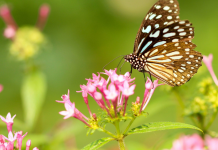 When springtime rolls around in late February to mid-March, each year millions of people of the Hindu faith and non-Hindus alike take to the streets (or gather in private) in their respective communities to celebrate Holi, the Hindu Festival of Colors. The annual festival has several different meanings and cultural significances. Holi is a day for all people, regardless of age, gender, race, class, or any other demographic, to gather in celebration of love and life. The two-day fest commemorates the transition from winter to spring, but also classic themes of death and rebirth, and the triumph of good over evil.
When springtime rolls around in late February to mid-March, each year millions of people of the Hindu faith and non-Hindus alike take to the streets (or gather in private) in their respective communities to celebrate Holi, the Hindu Festival of Colors. The annual festival has several different meanings and cultural significances. Holi is a day for all people, regardless of age, gender, race, class, or any other demographic, to gather in celebration of love and life. The two-day fest commemorates the transition from winter to spring, but also classic themes of death and rebirth, and the triumph of good over evil.
When My Fascination for Holi Began
Growing up in Northeastern Ohio, I attended a very culturally diverse grade school where many of my friends were of different faiths and cultures than my own. It was then that I first learned of Holi and other festivals and traditions of the subcontinent of India.
Several years later, while living in New York City, I attended a Holi street festival that I heard about through my yoga studio. The party was one of my most memorable experiences while living there! The vibe was nothing short of amazing – people of all ages having so much fun and zest for life, with music and dancing and food trucks galore. I can remember seeing revelers coming off the subway splattered in a tie-dye of colors from a Holi party in Brooklyn. The energy was surreal; a childlike and whimsical nod to spring commemorated in an ethereal, and very colorful, way.
It was then that my fascination took hold.
Fast forward to present day, my almost-four-year-old son and I love reading books about different cultures and festivals. One such book, the Festival of Colors by Surishtha Sehgal and Kabir Sehgal (which we borrow from the Mount Pleasant Library), explains the meaning behind Holi and the symbolism behind its colors in a very easy-to-understand story. My son loves it, as do I.
Always curious about this festival, I dug in to do more research for this article. Please note: I am not Hindu, and I did not grow up participating in Holi. However, I do have a deep fondness for different cultures and religions, and am particularly fond of those found in India and the Indian subcontinent. I am sharing this information with the hopes that it might inspire you and others to enjoy Holi as well.
 What is Holi?
What is Holi?
Holi, otherwise known as the Festival of Colors, is an annual Hindu festival marking the start of spring. It’s a joyous, two-day celebration, with roots dating back to ancient India.
Presently, Holi is celebrated in India, Nepal, but also throughout Asia, North America, and elsewhere throughout the Indian diaspora. It is celebrated by people of the Hindu faith and by non-Hindus alike.
This year’s Holi festival takes place today, on Monday, March 25, however, the religious and symbolic festivities begin the night before on Holika Dahan (the event is called Chhoti Holi, or “small Holi”). This day is commemorated by prayer (“puja”) and the lighting of a bonfire, according to this Travel + Leisure article. The bonfire symbolizes the triumph of good over evil and is meant to wash away all that is bad.
The following day, on Purnima, the day of the last full moon in the Hindu calendar month of Falgun (sometimes spelled Phalguna), starts the festival of colors: a veritable celebration of life and living. This day consists of launching colored powders (called “gulal”) or colored water (called “pani”) at friends, family, and strangers too! Historically, the powders were made from grinding up dried flower petals, although modern powders are commonly made with synthetic materials.
Holi is meant to be fun and celebratory, with the different colors carrying different significance. Blue symbolizes the Hindu god Krishna, who has blue skin and is a manifestation of Vishnu, one of the three main deities in Hinduism. This Smithsonian Magazine article explains that the color blue also represents Vishnu’s triumph over evil. Green symbolizes rebirth and new beginnings, red evokes marriage and fertility, and yellow signifies auspicious occasions, which Holi (and full moons in general, in Hindu tradition) most certainly is.
Like the origins of the festival, the use of the colors is also steeped in folklore. One such story is that Lord Krishna’s mother, Yashoda, applied gulal to Radha, Krishna’s friend’s (or wife or lover, depending on which version of the story is told) face because she was fairer than Krishna, who had a darker skin tone and wanted her to accept him. Other variations on this story exist, but that is the gist and one explanation as to why color is used to celebrate Holi today. Colored powders are also used in other ceremonies as well, including weddings and funerals.
Another big component to Holi of course is food. Sweets are common, but also savory snacks are enjoyed in the good company of friends and family. And don’t forget dancing! This is, after all, a celebration of life.
 Folklore Behind Holi
Folklore Behind Holi
The folklore behind Holi dates back to ancient India. Many versions of stories exist as to how and why Holi started, like the abovementioned Krishna story.
Yet another explanation of the folklore behind Holi can be found in this Associated Press article. The article explains that King Hiranyakashipu wanted all those in his kingdom, including his son Prahlad (sometimes spelled Prahalad), to worship him and not Lord Vishnu. When his son resisted, the king ordered his sister Holika, who was considered immune to fire, to take Prahlad with her into a fire pit. The pyre was lit, and legend has it that Prahlad survived because of his devotion to Lord Vishnu, whereas Holika perished.
Regional variations of this story exist too, but this is yet another common explanation as to why Holi is celebrated.
Where to Celebrate in Charleston
Want to celebrate Holi in Charleston? Mark your calendar for next year as Coterie Restaurant downtown throws an annual bash! Yesterday, on Sunday, March 24, Coterie hosted its 3rd Annual Holi Festival. For a nominal cover charge of $5, revelers enjoyed color throwing, dancing, and live music provided by DJ Feelwick, along with Chef Damian Sandoval’s Indian street food. Drink specials were also provided featuring event sponsor Nock Tequila.

Attending a Holi festival? Don’t forget to wear white and be prepared for it to be colorfully decorated by the end!













